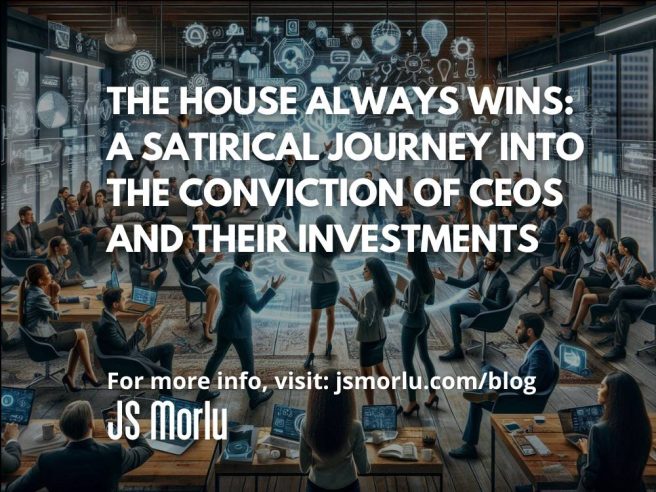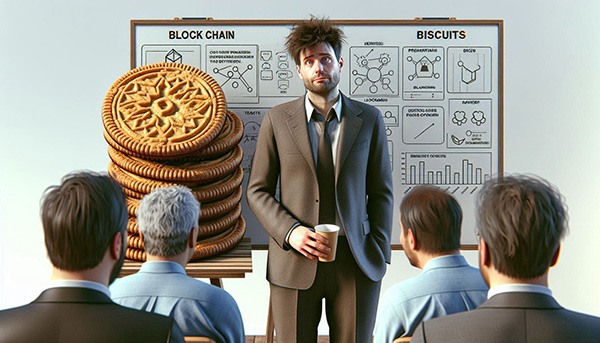By: John S. Morlu II, CPA
In the high-octane world of startups, venture capitalists, and CEOs, there are only two kinds of people: those who bet the house and those who prefer to put their money in their grandmother’s savings account. This dichotomy isn’t just a playful metaphor; it’s a defining philosophy that shapes the very fabric of the entrepreneurial landscape. As fortunes rise and fall in the blink of an eye, one name stands above them all—Samual Albatross, the supreme leader of OpenAir Ventures. A man of limitless ideas and even more limitless questions, Albatross is revered for his ruthless philosophy: Full conviction or bust.
“I need to know if you’re all in or all out,” Samual would bark at his young, aspiring lieutenants, his fingers a blur as they danced over his holographic Rubik’s Cube, a peculiar but fitting emblem of his approach to the chaotic world of investments. “And if you’re not, why are you even wearing pants?” It’s a phrase that’s become legendary in the startup scene, a battle cry for those brave enough to ride the rollercoaster of risk and reward that defines their existence.
Now, if you’re not familiar with Samual’s world of investment, don’t worry. It’s a place where every decision is painted in extremes, where investors never half-believe in anything. In this realm, the “bet-the-house” mentality isn’t just a strategy; it’s gospel, fervently followed by those who aspire to greatness and feared by the faint of heart. But this black-and-white philosophy also makes things… well, interesting. Picture a high-stakes poker game where the chips are not just money but dreams, ambitions, and sometimes, friendships. Every meeting can turn into a theatrical performance, every pitch a potential epic saga of triumph or disaster.
Within the walls of OpenAir Ventures, innovative ideas fly like confetti at a New Year’s celebration, each one vying for attention as eager investors hover like hawks, ready to swoop in at the slightest hint of a promising opportunity. Yet, the atmosphere is electrifyingly charged with tension—where every hopeful entrepreneur faces a critical litmus test of their conviction. You can almost hear the unspoken challenge in the air: “Are you ready to gamble everything for your dream, or are you just here for the free coffee?”
But what truly sets this world apart is the personality behind it all: Samual Albatross. A maverick of unmatched charisma and intellect, he embodies the essence of the startup spirit. With a penchant for wild ideas—like a robotic pet that predicts stock market trends or an app that counts the number of selfies taken in a day—he has built OpenAir Ventures into a formidable force, attracting a roster of entrepreneurs as colorful and eccentric as his vision. However, beneath the glossy surface lies a reality where not every bold idea gets the green light, and the repercussions of failure can be as brutal as they are enlightening.
In this thrilling exploration, you’ll be taken on a journey through the chaotic, exhilarating world of high-stakes investing, where the line between success and failure blurs and where the stakes are often personal. You’ll witness the fierce battles of conviction that unfold in boardrooms, the exhilarating pitches that leave investors breathless, and the moments of doubt that make even the most hardened entrepreneurs question their path.
So buckle up, dear reader. In a realm where every decision is a gamble, and where the only rule is to play to win, you’re about to dive headfirst into the unpredictable universe of Samual Albatross—a world where dreams are either fueled by unshakeable belief or left to wither away in the safety of mediocrity. Whether you’re a budding entrepreneur, an investor, or simply a curious observer of the startup phenomenon, prepare to be captivated by the stories that unfold in the thrilling pursuit of “all in.”
Chapter 1: The Cult of Conviction
Let’s start with Harriet Harpoon, a fresh-faced, wide-eyed recruit at OpenAir, who one day had the audacity to present her idea: PocketLox, a revolutionary app that promised to revolutionize the way people kept track of where they last saw their car keys. “It’s simple,” Harriet explained confidently, “We use AI to scan your pockets through your phone, so you’ll never lose your keys again. We call it ‘Keytelligence.’”
Samual stared at Harriet from across the boardroom, his eyes narrowing with laser-like focus.
“Are you betting the house on this?” he growled.
Harriet blinked. The house? Her house was a studio apartment with a leaky faucet and a landlord who communicated exclusively through Post-it notes. But, remembering Samual’s motto, she nodded vigorously. “Yes, Samual. I’m betting all the houses.”
“Good,” Samual said, leaning back with a satisfied grin, “because if you weren’t, I’d have thrown you and your idea into the recycling bin.”
Conviction, Harriet learned that day, was not just about believing in something. It was about believing in it violently. Either you walked into the room with so much belief that you could make a cactus sprout roses, or you might as well be selling lemonade to Elon Mustache (the infamous tech magnate, who also held a world record for “most failed lemonade stands on Mars”).
Chapter 2: Full Conviction, Zero Logic
In the high towers of OpenAir, another day meant another startup pitch. Enter Mark Meltdown, a man with what he called “an invention so groundbreaking, it will change how humans breathe.” His company? Airify, an app that let you buy “premium air” for a subscription fee of $49.99 per month. With Airify, you could be sure you were breathing the best air, the top 1%, filtered directly from the Swiss Alps.
“You know,” Mark pitched excitedly, “we’ve realized there’s a massive opportunity in selling air! Sure, air is free, but people like paying for things. Look at bottled water!”
This time, Samual’s reaction was immediate. “Are you betting your house on this? Your car? Your great-uncle’s vintage stamp collection?”
Mark’s conviction had been shaky up until that point. Sure, he believed in premium air, but he wasn’t stupid. Still, under the glare of Samual’s demanding gaze, Mark gulped and nodded. “Absolutely, Samual. I’m betting the house. In fact, I’m betting my mom’s house. I’m also betting my neighbor’s house.”
Samual slapped the table, beaming. “Now that’s the spirit! If you’re not willing to go bankrupt for the idea, it’s not worth pursuing. Let’s make it happen. Ten million for Series A, and don’t let me down.”
As Mark walked out, grinning ear to ear, Harriet pulled him aside. “Do you actually believe in that idea?” she asked, eyes wide with curiosity.
Mark looked at her for a long moment. “Oh, God, no,” he whispered. “I haven’t believed in anything since the fifth grade. But Samual, man… he makes you believe. Or at least, he makes you lie about believing.”
Chapter 3: The Rise of MicroConvictions
As the weeks passed, Samual’s disciples began to embrace his gospel of extreme conviction. The office was abuzz with reckless enthusiasm. Some bets paid off handsomely, but others… well, let’s just say that not every house survived the storm.
Take, for instance, Jake Jitters, founder of Biscuit.io, a blockchain-based platform for tracking the historical lineage of biscuits. “Think about it,” Jake had explained, “How do you really know where your digestive biscuit came from? With Biscuit.io, we can ensure that no impostor biscuits sneak onto your plate.”
Samual’s eyes had gleamed. “That’s the most ridiculous thing I’ve ever heard,” he said. “Are you betting the house?”
Jake, who had recently discovered that his apartment was not, in fact, a legal residence, and therefore had no house to bet, made a bold move. “I’m betting the internet,” he declared, perhaps forgetting the limits of human capacity.
Samual approved the deal, naturally, and Biscuit.io raised an incredible $500 million in funding. However, after a rocky launch (where people realized they didn’t really care about their biscuits’ DNA), the company crumbled like a soggy digestive in tea. Jake was last seen at a quaint café, muttering about biscuits and existentialism while trying to convince people that cookies were just biscuits in disguise.
Chapter 4: A Tale of Too Much Conviction
But it wasn’t all easy wins in the world of full conviction. Sometimes, as Bobby Boomtown learned, conviction had consequences. Bobby had pitched FluffCoin, a cryptocurrency based entirely on how “fluffy” an item felt. “Imagine,” Bobby said, “a currency that’s valued by the softness of kittens or the texture of luxury carpets!”
The concept was strange but intriguing. Samual’s eyes narrowed as they always did, and he gave Bobby the same treatment.
“Are you betting your house?” Samual demanded.
Bobby, whose condo was one eviction notice away from the gutter, nodded. “Absolutely. I’m betting my house, my pet hamster, and my collection of Hawaiian shirts.”
Samual smiled. “Then we’re in business.”
To everyone’s surprise, FluffCoin actually took off. Celebrities began endorsing it, and it wasn’t long before tech influencers claimed that the future of finance was built on “softness metrics.” Unfortunately, like most fluffy things, it didn’t last. The market crashed after an unfortunate scandal involving counterfeit fur, and Bobby found himself sitting on a pile of worthless cryptocurrency and questioning his life choices.
Chapter 5: Back to Reality
One thing was clear: in the world of Samual Albatross, there was no room for half-hearted commitment. The landscape was littered with the bones of those who had failed to fully commit—or worse, who had committed too much.
Harriet, reflecting on her journey, realized that there was a kind of elegance to the chaos. Sure, she had bet everything she had, but she had also learned the most important lesson of all: full conviction didn’t have to mean blind faith in an idea. Sometimes, it was about convincing yourself and everyone else that you believed in something so much that failure wasn’t even an option.
Of course, as Harriet would later tell her therapist, it was also about knowing when to stop drinking the Kool-Aid. “I think I might need to draw the line at Pet Pebble, the new app for adopting virtual rocks,” she confessed one day. But Samual Albatross had different plans.
“You’re betting the house?” he’d asked her with a gleam in his eye.
Harriet smiled, fully aware of the absurdity. “You know what, Samual? I’m betting all the houses.”
And so the saga of Bet-the-House Ventures continued, fueled by a cocktail of ambition, blind conviction, and just the right amount of insanity. As Samual always said, “In the world of investment, you’re either betting the house or you’re not even at the table. And if you’re not at the table, you’re probably working at some sensible job that offers dental insurance.”
But then again, where’s the fun in that?

Chapter 6: Patriotism or Subversion?
The office was buzzing, but not with the energy of productive work. No, the buzz was the sound of whispered allegiances, secret meetings, and hushed conversations behind closed doors. The clash between two titanic personalities—Harvey Hanley and Jen Jeffries—had spilled over into every aspect of daily office life. What had once been a united team of professionals at Republic Solutions had now fractured into two fiercely opposed camps.
On one side stood the Hanleyites, staunch believers in the idea of collective decisions and policy loyalty. “Once a decision is made,” Hanley had declared in a leadership meeting, “it becomes our decision. We refine it, tweak it, but we don’t tear it apart. That’s how a company moves forward.” The Hanleyites took these words to heart, clutching them like gospel verses. They believed that internal dissent was more dangerous than the occasional wrong turn. It was like taking a family road trip, they argued: even if Dad missed the exit, the kids didn’t start protesting in the backseat—they just worked together to find a new route.
The Jeffriesites, on the other hand, were rebels with a cause. “Loyalty to a flawed system is more dangerous than dissent,” Jen Jeffries had famously said during an office-wide email debate. In her view, patriotism wasn’t about blind loyalty; it was about speaking truth to power. The Jeffriesites would rather sink the ship than let it steer into an iceberg just to maintain a sense of unity. To them, subversion was not only justified but sometimes necessary to prevent disaster. After all, what kind of loyalty was it if you let the company collapse just to protect someone’s fragile ego?
The lines between patriotism and subversion were blurred, as both sides claimed to be the true defenders of Republic Solutions’ future. The Hanleyites accused the Jeffriesites of undermining the company’s stability, while the Jeffriesites viewed their opponents as corporate drones marching towards mediocrity. The office became a battlefield, with each group fighting for what they believed was the greater good. But in the process, the question emerged: who was really acting in the company’s best interest? Was it those who supported the system, or those who sought to overthrow it?
Chapter 7: Ideological Warfare in the Workplace
What had started as a difference of opinion quickly escalated into a full-blown ideological war. The office, once a bustling hive of collaboration and shared objectives, now resembled a cold war-era spy thriller. The tension was palpable, and the office culture had descended into an atmosphere of mistrust, whisper campaigns, and guerrilla tactics. You could practically hear the theme music from “Mission: Impossible” whenever someone moved from desk to desk.
In the Hanleyite camp, Harvey doubled down on his stance. At every team meeting, he stood tall, urging his colleagues to adapt to the new policy and make the system work. “We’re professionals,” he said during one particularly heated meeting. “We don’t abandon the ship when it’s taking on water. We fix the leaks.”
Across the office, however, the Jeffriesites were staging their own revolution. Jen Jeffries, with the finesse of a covert operative, held off-the-record meetings in the break room, usually over microwaved leftovers. There, she and her followers discussed alternative approaches that subtly undermined the official company line. “Change doesn’t come from blind loyalty,” she whispered to her inner circle, chewing thoughtfully on a forkful of quinoa salad. “It comes from pushing the boundaries.”
The workplace now operated like a divided nation. Some employees quietly switched allegiances as the pressure mounted, while others chose neutrality, hoping to avoid the inevitable fallout. But there was no escaping it—the ideological battle was tearing the company apart. Productivity plummeted. Deadlines were missed. Clients were left hanging, and the once harmonious office was now a battlefield of conflicting values. Management watched helplessly as the situation spiraled out of control, unable to decide whether to throw their weight behind Hanley’s vision or embrace Jeffries’ rebellious spirit.
Chapter 8: The Crisis of Leadership
Caught in the crossfire of this office civil war was the company’s leadership, a group of managers who now found themselves in uncharted waters. The policy that had seemed so simple and unifying on paper had instead turned into a grenade that exploded in the middle of their workforce. How did a minor tweak to the company’s internal reporting system lead to such chaos?
The leadership team, led by CEO Linda Lawman, had initially believed the policy would streamline decision-making and enhance efficiency. Instead, it drove a wedge between employees, creating factions and fueling dissent. With the company’s productivity in free fall, Lawman called an emergency meeting with her top executives.
“I don’t understand how we got here,” Lawman muttered, glancing at the reports of missed deadlines and lost clients piling up on her desk. “How did a policy change meant to unify the team end up causing this mess?”
The executives sat in uncomfortable silence. Gary, the CFO, shrugged helplessly. “It started with Hanley and Jeffries, but now it’s infected the entire office.”
Samantha, the HR manager, cleared her throat. “We underestimated how strongly people felt about the policy. Both sides think they’re right, and they’re digging in their heels. But if we don’t fix this soon, we could lose half the staff—or worse, the entire company.”
Leadership faced a choice: continue down the current path and risk total collapse or find a way to bridge the growing divide. It was clear that the time had come for a radical shift in strategy. But what could possibly bring the Hanleyites and Jeffriesites to the same table without turning the office into a smoldering crater?
Chapter 9: The Search for Common Ground
Desperate for a resolution, CEO Linda Lawman decided that the only way forward was to bring both factions to the negotiating table. “It’s either this or we watch the company implode,” she had said grimly at the leadership meeting.
For the first time in weeks, Hanley and Jeffries were summoned to the same room, flanked by their respective followers. The air was thick with tension, as both sides sat with arms crossed, eyes narrowed. You could practically hear the distant echoes of dueling banjos.
The discussions were long and tense. Hanley, with his love for structure and collective decision-making, argued for preserving the spirit of the original policy while adding practical tweaks. Jeffries, representing the voice of dissent and innovation, pushed for a complete overhaul that would allow more flexibility and empower employees to question leadership.
Weeks passed, and the debates continued. At one point, Barry from accounting tried to pass a note suggesting everyone just “get over it and move on,” but he was promptly ignored. Finally, a compromise was reached. The new policy would incorporate input from both sides. The core structure would remain, as Hanley had insisted, but Jeffries’ concerns were addressed with amendments allowing for greater employee feedback and a streamlined mechanism for proposing policy revisions.
It was a hard-won compromise, and neither side was entirely happy. But they could live with it, and that was enough for now. For the first time in months, there was a sense that the company could move forward—though nobody was quite sure whether to cheer or simply sigh in relief.
Chapter 10: Living with the Decision
With the revised policy in place, the office at Republic Solutions slowly returned to a state of tentative calm. The coffee machines, once the site of whispered conspiracy, now buzzed with cautious small talk. Deadlines, which had been more myth than reality for a while, started being met again. But the scars from the ideological conflict remained.
Employees were more careful now, especially about voicing their opinions. After witnessing the intense battle between Hanleyites and Jeffriesites, many were unsure of where the line between dissent and subversion really lay. Was questioning a decision a sign of weakness, or a sign of loyalty to the company’s success? No one was sure anymore.
Harriet, who had avoided joining either faction, noticed that even the smallest suggestions for improvement were met with side glances and raised eyebrows. Jeffries had technically won the right to dissent, but now everyone seemed afraid of looking like too much of a rebel—or too much of a loyalist. The once vibrant, creative culture had dimmed slightly, as people tiptoed around ideas rather than charging at them with full conviction.
The story of Republic Solutions, with its clash of ideologies and hard-won compromise, became a cautionary tale in corporate circles. The message was clear: decisions, once made, are not the end of the story. They are just the beginning. The true test of any policy or decision isn’t the moment it’s rolled out but how it’s received, challenged, supported, or resisted by the people who live under it every day.
In the end, it wasn’t a question of patriotism or subversion. It was a question of balance—of finding common ground between conviction and flexibility, between loyalty and dissent. And if Republic Solutions’ journey proved anything, it was that walking that tightrope is easier said than done.
Chapter 11: Epilogue: The Lessons of Republic Solutions
Republic Solutions weathered the storm, emerging from its internal strife a company transformed—scarred, but stronger in unexpected ways. The battle between Hanley and Jeffries was more than just a conflict over policy; it was a battle for the soul of the organization. It highlighted that in any company, the heart of progress lies not merely in the policies implemented, but in the tension between loyalty and dissent, between conformity and questioning. These forces, which at first glance seem diametrically opposed, are both essential ingredients in the pursuit of long-term success.
The clash between Hanley and Jeffries revealed a fundamental truth: healthy organizations thrive on a delicate balance. Hanley’s steadfast loyalty to collective decisions ensured that the company maintained cohesion, yet without Jeffries’ bold willingness to challenge those decisions, stagnation would have been inevitable. Loyalty without challenge breeds complacency, while dissent without structure leads to chaos. It was the uncomfortable, often painful interplay between these two forces that pushed Republic Solutions to confront its own shortcomings and reimagine its future.
But perhaps the most profound lesson was that the hardest part of leadership isn’t simply making a decision—it’s living with the consequences. Republic Solutions’ management had believed that policy was king, that by drafting a seemingly flawless directive, they would cement the company’s path forward. What they failed to anticipate was that no policy, no matter how well-intentioned, could account for the complexities of human nature—their hopes, fears, and loyalties.
For weeks, the office had become a battlefield, a microcosm of ideological warfare where productivity ground to a halt and morale plummeted. But within that chaos, something critical happened: the employees—whether Hanleyites or Jeffriesites—began to engage with the company on a deeper level. They questioned not just policies but the very values underpinning the company’s decisions. Republic Solutions had unknowingly catalyzed a culture where employees no longer accepted things at face value but felt empowered to ask hard questions, engage in difficult conversations, and seek a higher standard.
When the truce was finally brokered and the new policy implemented, the scars of the conflict remained. The company had changed, but so had its people. They no longer viewed their roles passively but recognized their agency in shaping the company’s direction. This was not without cost. Many remained wary, hesitant to voice dissent or offer wholehearted loyalty, fearful of the blurred lines between patriotism and subversion. Yet, this wariness was not a weakness. It was a newfound wisdom, a sober understanding that in any organization, harmony is not the absence of conflict but the product of navigating through it.
Republic Solutions learned that compromise does not signify defeat; rather, it is a testament to an organization’s resilience. The greatest lesson was that leadership is not about perfection but about the ability to learn, adapt, and grow even when the ground beneath you is uncertain. A company is not defined by its policies alone, but by how it integrates those policies into the living, breathing fabric of its people.
The story of Republic Solutions became more than just a corporate tale—it became a parable for organizations everywhere. It taught that decisions, no matter how well-crafted, are only the beginning. The true test lies in the aftermath—how people live with those decisions, how they challenge them, and ultimately, how they evolve alongside them. Patriotism and subversion, loyalty and dissent—these are not binary forces but dynamic elements of an organization’s journey toward greatness.
In the end, Republic Solutions survived because it learned that progress is not a straight line, but a winding path, filled with bumps, bruises, and breakthroughs. And in that struggle, it found its greatest strength—not in avoiding conflict but in embracing it, navigating through the discomfort, and emerging on the other side, wiser, stronger, and more united than before. The legacy of Republic Solutions is a reminder that no company is static, that its greatest asset is not its policies, but the people who dare to question them, refine them, and live with them in pursuit of something greater.
Author: John S. Morlu II, CPA is the CEO and Chief Strategist of JS Morlu, leads a globally recognized public accounting and management consultancy firm. Under his visionary leadership, JS Morlu has become a pioneer in developing cutting-edge technologies across B2B, B2C, P2P, and B2G verticals. The firm’s groundbreaking innovations include AI-powered reconciliation software (ReckSoft.com) and advanced cloud accounting solutions (FinovatePro.com), setting new industry standards for efficiency, accuracy, and technological excellence.
JS Morlu LLC is a top-tier accounting firm based in Woodbridge, Virginia, with a team of highly experienced and qualified CPAs and business advisors. We are dedicated to providing comprehensive accounting, tax, and business advisory services to clients throughout the Washington, D.C. Metro Area and the surrounding regions. With over a decade of experience, we have cultivated a deep understanding of our clients’ needs and aspirations. We recognize that our clients seek more than just value-added accounting services; they seek a trusted partner who can guide them towards achieving their business goals and personal financial well-being.
Talk to us || What our clients says about us











